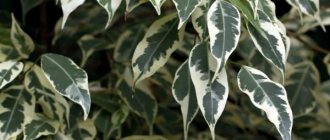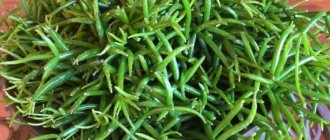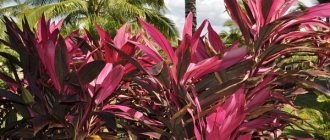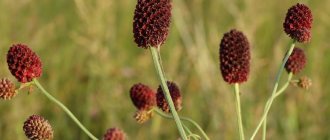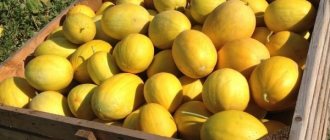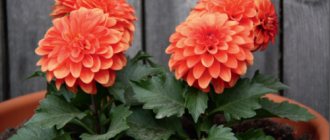Flowers in the house not only create coziness and complement the home interior, but also have a beneficial effect on the indoor climate. Among the wide variety of indoor plants, one cannot help but highlight the house ficus. This plant is elegant and beautiful, and the wide variety of species makes it possible to transform any corner of the house. As part of today's review, we will tell you how to properly care for a ficus at home, what types it comes in, and how these types differ in care. Along the way, we will talk about the propagation of this plant, what diseases and pests it is most susceptible to, and how to protect the flower.
Ficus is a beautiful and unpretentious plant
Brief botanical information
Ficus belongs to the Mulberry family. A representative of the genus is the fig and fig tree. Under natural conditions, the plant grows in Southeast Asia, on the islands of Ceylon, Borneo and Java, and is a mighty tree, up to 30 meters high with a huge spreading crown. The leaf blade is long and wide, reaching 1 m in an adult plant. The shadow from the plant covers a hectare of land.
In its natural habitat, ficus lives 400 years or more
Ficus: varieties with photos and names
Novice gardeners are often interested in what ficus is? This deciduous plant belongs to the Mulberry family. There are ficus trees, bushes and even vines. There are up to 1000 species in nature. The height of these plants can reach several meters. Domesticated ficuses are more modest in their growth, but are also not picky in their care.
Ficus trees are native to the tropical forests of Malaysia and the Philippines .
The climate of the Pacific and Indian islands, the Mediterranean Sea, South Africa and part of Asia suits them. Note! This tropical plant is an epiphyte.
It is able to use neighboring crops for its growth. Thus, ficuses in nature can survive other plants from the territory, forming thickets. These exotic flowers attract with their foliage ; people often call it “birch”. Depending on the type, leaf plates are:
- plain green;
- with spots;
- small;
- big.
Ficus trees have milky juice, which is used for medicinal purposes. Plants not only bloom, but also bear fruit. But this phenomenon can only be seen in nature.
Homemade ficus plants, in addition to beautifully complementing the interior, are capable of purifying the indoor air from harmful microorganisms. Therefore, by placing any of the types or a mix on your windowsill, you not only provide yourself with aesthetic pleasure, but also take care of your health.
Types of indoor ficuses - names and photos
In nature, there are 1,500 varieties of ficus, but no more than 20 species are grown at home, which differ in color and shape of foliage, as well as in maintenance and care. The most common ones include the following.
Benjamin. A beautiful, unpretentious plant that will complement any interior. It gained its popularity due to its flexible branches, from which you can create various shapes, as well as grow a bonsai tree. Benjamin needs a timely haircut, which makes the crown look full and well-groomed. But there are also disadvantages:
- the plant sheds its leaves in the autumn-winter period;
- afraid of drafts and sudden drops in temperature;
- does not tolerate direct sunlight. If the plant stands in full sun, the leaves fade and become thinner;
- If pruning is not carried out, the branches stretch out and the plant loses its decorative appearance.
Benjamin is one of the brightest representatives of the rubber
plant . This species has a varied shape, color of foliage and shoots. The plant does not require care, so it is loved by inexperienced flower growers and people who are often on the road. Advantages of this type:
- grows in any climatic conditions;
- does not require abundant watering;
- Grows anywhere and in any light.
The leaves of the rubber ficus are dark green or have a golden edge.
Rubber-bearing ficus is a common potted crop.
Ficus: description of the genus
Most species are epiphytes, forming aerial roots that, sinking into the soil, give rise to a new plant. The shape of the leaf blade is very diverse: with jagged edges, oval, heart-shaped, xiphoid or with a pointed end. Ficus trees contain a special white juice - milky, used in medicine, but if it comes into contact with the skin, the secretions of some species can cause irritation. The inflorescences are also different, they are grouped or grow separately, representing a dense ball with a hole in the upper part. Small flowers appear inside the sphere. At home, ficus trees bloom extremely rarely, since insects are needed for pollination. The fruits look like small nuts with pulp and many seeds.
Ficus flowering
Ficuses can be grown both in an apartment and on a personal plot. But everyone who has purchased this beautiful plant asks the question: can a ficus bloom?
One of the relatives of the ficus is the fig, and, as is known, this plant blooms and bears fruit well only in regions with a hot climate. The same can be said about ficus. To make it produce flower stalks, it is necessary to provide the plant with an abundance of sunlight, a very hot climate and create an atmosphere that is 100% close to natural conditions.
A plant grown in a harsh climate will never bloom, even if it is provided with additional lighting and heating.
What to do if the ficus does not bloom? All that remains is to admire the beauty of the ficus flower from the photo.
The plant can only bloom in a greenhouse
Dwarf ficus Pumila - plant appearance
Many gardeners praise the plant very much for its features, namely, its small size. Yes, the dwarf ficus will not take up much space on the window, which is why plant lovers want to get it. The flower grows very quickly; against the background of dwarfism, its leaves appear larger. In fact, the leaves of the ficus are the most common, the same as those of other large species. The length of the net leaf of Pumila can reach up to 8 cm. The leaves themselves have wrinkles and are rough to the touch. Their arrangement is such that on the ficus they grow in two rows.
In nature, Pumila is capable of producing shoots in the form of small pear-shaped shoots, which change color as they ripen. However, ficus usually does not bloom in people's homes, only in rare cases. And yet, growing ficus ampelous or creeping is a great pleasure for gardeners and plant lovers.
How to care for ficus at home
Although ficus is unpretentious in care, it, like any other indoor plant, requires a lot of care and love.
Soil selection
Young plants need light, air- and moisture-permeable soil, consisting of leaf soil, sand and peat in equal quantities. Adult ficus plants require dense soil; for this, turf soil, humus or compost are added to the soil. If you don’t have the time or desire to prepare the substrate yourself, you can purchase it at the store. Do not forget that purchased soil must be disinfected. To do this, pour boiling water or a hot solution of potassium permanganate onto the soil.
For good growth you need light and nutritious soil.
Lighting and humidity
Ficus is a light-loving plant, so it is better to grow it in a well-lit place; the light should be diffused and bright.
With a lack of lighting, the leaf plate becomes smaller, and the shoots begin to reach for the light, which greatly affects the decorativeness of the plant.
The best place for a flower is the eastern or western side, protected from drafts. There are varieties that grow well in partial shade; sunlight is contraindicated for such plants. For the growth of ficus, maintaining air humidity is also important. It should be no less than 50% and no more than 70%. In hot summers, the flower must be sprayed and given a warm shower. The water should be settled, soft and at room temperature.
For full development, the plant must be sprayed once a week.
Temperature
Since the plant comes from hot countries, it needs an air temperature in the range of 25−30°C in summer and 15−20°C in winter. In a cold room, the plant stops developing and sheds its leaves. Ficus does not tolerate sudden changes in temperature and hypothermia of the soil.
The warmer the air, the more light the ficus needs.
Watering rules
Ficus does not tolerate both overwatering and underwatering. When the soil is oversaturated with moisture, the foliage loses its color and falls off, and the root system may rot. If it is underfilled, the leaf curls, dries out and also falls off. In order for the plant to feel comfortable, you need to know a simple rule: watering should be carried out only when the earthen ball dries to a depth of 4 cm, and for adult plants drying to a depth of 8 cm is acceptable.
Watering is carried out with warm and settled water
How to feed a plant
During the growing season, ficus requires feeding for rapid growth. In spring and summer, nitrogenous fertilizers are used to quickly increase green mass.
If a plant sheds its leaves, then fertilizing will help it to rehabilitate faster.
Suitable fertilizers include: mullein, infusion of ash, nettle, as well as ready-made mineral fertilizers “Ideal”, “Gumisol”, “Ficus”. Application frequency: in summer – once every 10 days; in winter, the flower does not need fertilizer.
Pruning and crown formation
Caring for a ficus, in addition to watering and feeding, also includes pruning. This procedure is carried out to give the crown a certain shape, rejuvenate the plant and prevent diseases.
Pruning is the main thing in plant care
Before you start pruning, you need to decide on the timing. Spring is the time when a plant’s branches can be pruned to form a crown. After this procedure, the plant will become lush and begin to produce young leaves. Autumn is an unfavorable time for pruning. Since during this period the plant begins to use the accumulated nutrients, and when pruning, the owner of the flower deprives it of the necessary substances that help the plant to winter favorably.
How to trim a ficus correctly (video):
Ficus transplant at home
Flower transplantation is carried out annually in spring. To do this, you need to prepare a large pot, nutrient soil, and drainage (expanded clay, pebbles or broken bricks).
How to properly transplant a ficus at home:
- We carefully remove the flower from the pot along with the earthen lump.
- We clean the root system of old soil; to do this, the plant is kept in a container with water for several minutes.
- Fill the bottom of the pot 2-3 cm with drainage.
- We fill in the first layer of soil and compact it. Next, install the flower and gradually add soil so that no air cushion is formed.
- Water the transplanted plant abundantly.
The first fertilizing is applied no earlier than a month after planting.
Ficus transplantation is carried out every five years
Caring for a flower at home in winter
Ficus care in winter is significantly different from summer care.
Temperature-humidity regime . Although the plant is thermophilic, in winter the air temperature must be lowered to 15°C. The upper limit is 20°C. If the temperature is high, the plant will begin to shed its leaves. You also need to maintain air humidity. To do this, install an air humidifier or a container of water next to the ficus, spray it and take a warm shower.
Watering . With the onset of autumn, watering must be gradually reduced. In winter, irrigation is carried out once every 1.5–2 weeks with warm, settled water.
When watering with cold water, the plant's root system rots, which leads to its death.
Lighting . The plant also needs a lot of light in winter. To do this, additional artificial lighting is installed above the flower. Lack of light causes foliage to drop and growth slows.
Ficus needs a lot of light and warmth
Fertilizers . If the ficus grows without additional lighting, there is no need to apply fertilizer. With additional lighting, the flower will need feeding, but with a dosage half as much.
Proper care (video):
Types of ficus with small leaves
The championship belongs to Ficus Benjamin, which is a tree or bush with a branched crown, with numerous flexible shoots. They can be intertwined, curled, twisted, creating fancy shapes. Thanks to the natural plasticity inherent in this species, breeders have developed a large number of varieties with wonderful poetic names:
- Curley,
- Starlight,
- Irene,
- Natasha,
- Nicole,
- Borok et al.
They all differ in size, growth vigor, leaf shape, and color.
Ficus benjamina (Ficus benjamina) is a large shrub that grows well at home up to 3-4 m in height (although usually lower) and 1.5 m wide. It has many branched woody shoots on which small, about 3- 8 cm, lanceolate, glossy, leathery leaves with a sharp tip. A characteristic feature of F. Benjamin is its “weeping” crown. It has many varieties with different sizes and colors of foliage.
The leaves may be white or yellow, wavy, curled, or completely green. The species grows quickly - within a few years it forms magnificent trees. It needs a lot of light, otherwise it will lose its leaves.
May have green leaves or white-green and yellow-green varieties ('Variegata', 'Starlight'). There are also low varieties, they are easier to grow in an apartment, and sometimes they are suitable for bonsai (for example, “Ester”, “Natasha”).
Ficus benjamina
This type of ficus is the most popular tree variety. The variety includes both tall and dwarf plants. Ficus can reach up to 2 meters in height, so it is perfect for keeping at home and in public spaces. The shape and color of the leaves, depending on the plant variety, can also be very different. The leaves of this variety reach from 6 to 12 cm in length and from 3 to 6 cm in width, can be either green or peach in color and have white inclusions. Ficus tolerates cutting well, so the crown can be given any shape. Features of caring for this type of ficus:
- It can be found in either a dark or a bright place (depending on the color of the leaves).
- The plant does not like to "move".
- Ficus does not tolerate frequent watering, but dry soil is also unacceptable.
- Direct sunlight is harmful to this ficus.
Starlight
This is a decorative indoor plant. Most of the leaves are variegated, but some are completely light, narrow in shape, wavy at the edge, up to 5 cm long. The young plant looks like a bush; bonsai is grown from it. Indoors it reaches a height of no more than 1.5 m.
Ficus Natasha
Photo: ficus Natasha
A beautiful name, a beautiful flower, although it is usually called a shrub that can overcome the growth mark of 2 meters at home. Ficus Natasha is a variety of Benjamin, which is distinguished by a large number of thin shoots and multiple small leaves. The latter have a rich range of shades, starting from white-green and ending with dark marsh. The leaf blade has an ellipsoidal shape with a slightly pointed tip.
These types of ficus love consistency and warmth, so it is not recommended to rearrange them or keep them in a draft. Regular shaking of the volumetric crown, irrigation a couple of times a week, and the flower will delight you with beautiful blooms for many decades.
Kinky
Photo: ficus kinki
This is a dwarf tree with small narrow leaves that have a light green tint and cream edging on all sides of the leaf blade. On some, however, light and casual spotting may be noticed.
Ficus kinki loves sunlight very much, but at the same time, direct sunlight, like drafts and dryness, is strictly contraindicated for it. You should not often move the plant to a new place, because it will often shed its leaves, and over time it may even die.
Important! As for watering, it is carried out as often as possible, but you should still not overdo it, because this is fraught with rotting of the root system.
Monique
Monique looks like a spreading tree, up to 3 m high, with medium-sized golden foliage no longer than 7 cm. The edge of the leaf curls in a small wave. Young plants have a vein in the center of the leaf; as they grow older, it disappears. The branches of the ficus are thin, inclined downwards.
Golden King
This ficus has green matte leaves, edged with a lemon-yellow stripe, no longer than 7 cm; in the middle of the leaf blade there is only one large vein. In nature, these ficus trees look like thirty-meter trees with huge aerial roots. Indoors, the plant can reach ceiling height.
Danielle Daniella
The height of Daniel in nature does not exceed 30 m, but the houseplant, similar to a tree, has a height of no more than 2 m. Oval leaves, saturated with greenery, grow up to 8 cm. In young plants they are light green, darkening with age. Ficus blooms only in its natural environment.
Ficus produces poisonous milky sap, be careful!
Microcarpa
The presented ficus is often confused with one of the varieties of Ficus Benjamin (variegated), although it is quite unique. The root system of this variety boasts accelerated growth, and the leaves boast their diversity. Today there are types of ficus of this type with elongated, oval and even elongated leaf plates.
Photo: ficus microcarpa
As for the rhizome, it resembles the roots of ginseng.
Important! Not all Microcarp ficuses have the same root system. This is due to a special growing method.
If you want to have rhizomes like ginseng, then you should perform a series of agricultural practices aimed at using special fertilizers and hormonal supplements. Experts note that it is quite difficult to implement the plan at home.
In nature, tall ficus (and it grows up to 25 meters) is not planted next to other plants and flowers, because this variety, which is popularly called the “strangler,” wraps around the trunks of nearby bushes and trees.
At the same time, at home, a flower with “ginseng” roots is used to create bonsai, which is facilitated by multiple and unusual rhizomes.
Robusta
Photo: ficus robusta
Despite many guesses that the presented species is a variety of Benjaminaceae, it belongs to another family - the rubber family.
In their natural habitat there are trees up to 60 and sometimes even 70 meters high. Although 30-40 meters is considered the norm. At home, the tree has a height of several meters, and this is the maximum that the plant is capable of.
Experienced gardeners recommend that beginners purchase this particular ficus flower, which has large, fleshy, spotted leaves reaching a length of 30 cm. Some varieties boast leaf blades with light yellow patterns, others have dark green streaks.
For good growth, ficus robusta must be provided with partial shade and abundant watering.
Ficus lyrata
Varieties of ficus get their names due to their habitat or based on the shape of their leaves. This specimen got its name from the resemblance of the foliage to a lyre (ficus is also known as “lyre-shaped”). It is large, can reach up to 50 cm in length and up to 25 cm in width. On the outside, the leaves have a smooth dark green color, on the reverse side the plate is light green. The ficus itself is a fairly large tree, capable of growing up to 2.5 m. Speaking of care, it is worth noting that this variety is one of the most difficult to maintain at home. For this ficus it is necessary to provide conditions as close as possible to natural ones. In addition, it must be trimmed regularly so that shoots and leaves do not grow chaotically. To ensure that your ficus grows well and makes you happy, care for it as follows:
- Avoid direct sunlight.
- Protect your ficus from sudden temperature changes.
- Provide plenty of watering, as ficus loves high humidity.
Ficus Binnedika
The second name of the plant is Ficus Ali. Like other varieties of ficus, it is an evergreen variety, shaped like a shrub or tree. It has features similar to a palm tree: an even trunk with a lush rosette of narrow oblong leaves in the upper part (can be plain or variegated). If the ficus is kept at home, it needs to be provided with good lighting. Light partial shade is acceptable. Regarding care and watering conditions:
- Cold and drafts are destructive for this ficus. The temperature in the room where the flower is kept should be from +13 to +25 degrees.
- To enhance the stability of the ficus, support is needed.
- You need to water the ficus depending on the time of year: in the summer - when the top layer of soil dries out, in the winter, watering is carried out when all the soil in the pot dries out.
How to properly care for ficus trees depending on the type
Kinky
Kinky is a miniature variety of Benjamin.
Care:
- The plant loves diffused light, so it is better to place the pot on the east or west side.
- The air where ficus grows should not be too dry.
- Watering is plentiful, but moderate.
Kinki - a dwarf variety of Benjamin
Melanie
Melanie is a type of rubber ficus, considered the most popular and unpretentious ficus.
Care:
- Needs periodic feeding and timely replanting.
- The light should be diffused, but not bright.
- Water immediately after the top layer of soil dries.
Melanie is the most unpretentious variety
Lyre-shaped ficus
The plant got its name because the dark green large leaves resemble a lyre or violin.
Care:
- Requires a favorable microclimate close to natural.
- Loves high air humidity and does not tolerate direct sunlight.
- The variety is sensitive to changes in temperature.
Lyre-shaped variety - the original shape of the foliage made this variety very popular
Microcarpa
The variety got its name due to the small size of the fruits. At home it is grown as a bonsai.
Care:
- The plant does not tolerate direct sunlight and requires periodic spraying.
- Water abundantly, especially in winter, since drying out of the earthen coma leads to the death of the plant.
Microcarpa is an ideal variety for growing bonsai
Natasha
Natasha is a dwarf variety of Benjamin. The variety comes with plain and variegated leaves.
Care:
- Warm, bright room without drafts.
- Watering is regular and moderate.
- Air humidity not less than 60%.
- Transplantation - once every 5 years.
Unpretentious variety Natasha
Robusta
One of the earliest and most widespread varieties of ficus rubber. The name of the variety comes from the English word robust, which means strong, healthy and strong.
Care:
- Air temperature – up to +22−25°C.
- A bright or shaded place.
- Moderate watering with warm, settled water.
- Air humidity is above 50%.
Robusta is the most famous variety of rubber ficus
Elastica
Ficus of this variety is considered a tree of prosperity. It protects comfort in the home and maintains relationships in the family.
Care:
- Can grow in both sun and partial shade.
- Temperatures in summer are up to +30°C, in winter – up to -15−20°C.
- Stable and balanced watering.
- Feeding - once a month in spring and once every 14 days in summer.
Ficus elastica - tree of well-being
Ali
The variety is unpretentious and looks unusual. The difference from other ficuses is the size and shape of the leaf. This is a narrow-leaved plant with drooping shoots.
Care:
- Does not tolerate sudden temperature changes and soil hypothermia.
- Humidity should be moderate. On hot days, spray and warm shower.
- Watering is abundant and moderate.
- Feeding - once every 10 days.
The narrow-leaved variety Ali is not only unpretentious, but also very beautiful
Ginseng
Ginseng is often grown in bonsai form due to its trunk, which looks like tied roots. Dark olive leaves form a neat crown.
Care:
- Grows well in partial shade.
- The optimal temperature for development is up to +16−22°C.
- Does not tolerate soil drying out.
Ideal for growing bonsai
Catalog of indoor flowers with photos and their names. In a special publication on our portal we will talk in detail about indoor flowers. You will learn the types of indoor flowers, about fruit indoor flowers and get acquainted with the photo gallery.
Classification of ficus
The ficus genus includes slightly less than 1000 species. Only a small part of these varieties is used in cultivation as ornamental plants. For convenience, ficuses, according to their structure, are conventionally divided into tree-like, ampelous and shrubby.
Ampelous
The ampelous varieties include low-growing creeping plant varieties. They do not have a central stem; the plant grows in long, thin shoots that hang down. In general, these varieties are very similar to vines or ivy.
A distinctive feature of such ficuses is that they tolerate shadows easily, so they are used to decorate walls, stairs, etc. Ficuses reproduce well, and hanging ones take root very quickly.
Hanging ficuses include Pumila (the most popular variety), Mountain, Creeping, Rooting, etc.
Shrubs
Shrubs include tall and low-growing specimens with branching or erect shoots. Unlike ampelous varieties, shrubby ficuses have one or more lignified dense stems-trunks.
Shrub species and varieties can grow either from one central stem or from several trunks. The leaves of these specimens are mostly oval, tapering towards the tip. The color of the leaf blades can be either a rich green hue or variegated.
The most popular types and varieties of ficus, Rubber-bearing and Benjamina, are considered shrubs. Also included in this category are Ficus Benedicta, Melanie, Carica, Parcella, Varifolia, etc.
REFERENCE. The division into shrub and tree-like ficuses is very arbitrary, since thanks to the success of selection, there are a variety of forms of varieties of the same plant species.
Tree-like
As the name implies, these ficuses have the form of a small tree at home. They have a woody central stem that already branches and produces additional roots. In general, if it were not for adventitious and aerial roots, then such varieties would be indistinguishable from trees familiar to us.
Leaves grow on branches on small petioles. The shape of the leaf plates is different: from ovoid and heart-shaped to oval and even xiphoid. Also, the leaves can be covered with wax, be glossy, have “fluff” or hard “hair”.
INTERESTING! Some specimens of the plant are grown as bonsai.
Tree-like ficuses include Microcarpa, Retuza, Blunt, Bengal, etc.
Features of home care for small-leaved varieties and ficus with large leaves
Small-leaved varieties of ficus have received great love from many gardeners for their unpretentiousness and beautiful appearance. Small-leaved ficuses are those whose leaf blade length does not exceed 4 cm. These include: Benjamin, Willow-leaved, Variegated, Boxwood.
Leaf length does not exceed 4 cm
Ficuses with large foxes include: Rubber variety, Lyre-shaped, Bengal and Rust-leaved. Caring for small-leaved and large-leaved ficuses is significantly different. Ficuses with large leaves tolerate minor drought well, but for small-leaved varieties, lack of moisture leads to death. This is explained by the fact that ficuses with small foliage have a much deeper root system than their counterparts. When overwatered, large-leaved ficuses begin to shed their foliage, while small-leaved ones, on the contrary, shed their leaves during drought. Air humidity for ficuses with large leaves does not play an important role, but for plants with small leaves, high humidity is the key to good growth.
Flower design.
From a design point of view, the ficus is an ideal plant. A special place will be occupied by Ficus rubiginosa variegata. Also, Ficus rubiginosa variegata will go well with other ficus trees. It can be used in a single planting and to highlight an area in the room. You can combine several different varieties of one type of ficus, or you can combine several, using some types of ficus and other types of ficus in one composition. Also, if you select other plants with similar growing conditions, the composition will be unique and versatile. Ficus rubiginosa variegata will go well with decorative foliage or flowering plants. When composing compositions, you can use different varieties and types of ficus: ficus sacred, ficus small-leaved, ficus bush, ficus birch, ficus ampelous, ficus climbing, ficus loosestrife, ficus rubiginosa, ficus rubiginosa variegata, white ficus, ficus nerifolia, ficus tonningi, ficus tiny , ficus altissimo, ficus cherry. But ficus baroque care at home is the same as for all types of ficus. Use ficus mix; with this composition, each ficus leaf will play its role. You can pay attention to certain types of ficus, for example ficus sacred, it is better to separate them into a separate composition. and small-leaved ficus will also look good in an individual composition. Good luck to you
How to form a bonsai from a ficus
If you want to grow a bonsai from a ficus, then you need to:
- Choose your favorite variety. The following ficuses are suitable for this: Bengal, Benjamin, Microcarpa, Carica, Dark-leaved, Rust-red. What a ficus bonsai looks like, photo.
Bonsai from different varieties of ficus
- Decide on the form. As a rule, when growing bonsai, one of the following forms is used: erect, irregularly erect, inclined, forked, broom-shaped, grove.
Beautiful forms for bonsai
- Formation of roots and crown. Roots and shoots are pruned until the required volume of the trunk is reached. Once the tree reaches the desired size, you can begin to form the crown and trunk.
Diagram of root formation.
Method of pruning the root system
How to propagate.
- Reproduction. The main type of propagation of most ficuses is cuttings. To do this, you need to cut off part of the shoot and root it in a separate container. Some types of ficus can be propagated by leaves - but this is a rather labor-intensive process. Ampelous forms - can be propagated by layering or suckers, part of the shoot can be rooted. more details here.
Ficus propagation
Ficus trees can be propagated in two ways: cuttings and air divers.
Cuttings - this method is easy and very simple:
- We choose a healthy cutting, the main thing is that it cannot be taken from the apical shoot, since the young seedling will not take root. The stem of the cutting should be well developed and have a dense texture.
- Separate the stalk with a sharp tool. Its length should be no more than 15 cm.
- Place the seedling in water for two hours to remove the milky juice.
- Remove the lower leaves and place in a container with clean warm water.
After 14 days, the plant will produce its first roots. As soon as the root system grows a little, the plant is planted in a pot with nutritious soil.
The easiest and simplest way to reproduce
For quick rooting, the plant is given a warm shower or periodic wiping of the leaf plate with a damp swab.
Taps . Another popular way to propagate ficus. To do this, a 15 cm stalk is separated from the plant and all lower leaves are removed. A circular cut is made on the seedling, a piece of wood is inserted into it, wet moss is applied to the cut site and wrapped in polyethylene. This procedure is necessary in order to create a favorable microclimate for the formation of the root system. When the roots sprout, separate the rooted cuttings and plant them in prepared soil.
Cuttings for propagation must be at least 15 cm
How to water
– Watering should be moderate and plentiful at the same time. Do not allow the soil to dry out or become too wet. In summer, watering should be moderate. Water for irrigation should be soft and settled. In winter, we reduce watering.
- Feeding. It is carried out together with watering in spring and summer. From March to September we fertilize twice a month. We use liquid mineral fertilizers that can be diluted in water for irrigation.
Diseases and pests of ficus
Ficus in unfavorable conditions can be exposed to some diseases, but insect pests are much worse for the plant.
Mealybug . This pest can be easily detected, as it looks like a piece of brown cotton wool. In this case, the plant is treated with folk remedies.
Aphid . This insect is dangerous not only to ficus, but also to nearby plants. Treatment consists of spraying the foliage with a soap solution. When a flower is infected with aphids, it is quarantined until it is completely recovered.
Thrips . This insect lives on the inside of leaves. The parasite is dangerous because it sucks all the juice from the plant and leads to its death. Treatment consists of repeated treatment with Pyrethrum solution.
Nematodes . These parasites infect the root system, laying their larvae on it. If no help is provided, the worm secretions will penetrate the ficus trunk and destroy it.
Shield . When attacked by this insect, brown spots form on the outside of the leaf blade. The fight consists of spraying the plant with a soap solution and treating the leaf with Acctelik. If the plant is not given proper care, fungal diseases may occur:
Fungus on leaves . The fungus manifests itself as black spots on the foliage, which lead to drying out and death of the leaf plate.
Gray rot . The disease appears in too hot a room and when the ficus is overwatered. During the disease process, mold appears on the stem and leaves, which when shaken easily flies off the plant. Treatment consists of removing the affected areas. Prevention: moderate watering and frequent ventilation of the room.
Sooty mushroom . A gray coating appears on the leaves. To get rid of a fungal disease, you need to regularly wipe the foliage with a soapy solution. In case of mass infection, it is better to remove the affected leaves from the plant to avoid the spread of the disease.
Root rot . When affected by the fungus, the ficus becomes gray and dies. No cure has yet been found for this disease.
Improper care leads to fungal diseases
How to get rid of midges in indoor flowers using simple methods. In a special publication on our portal, we will talk in detail about how to get rid of pests in indoor plants. You will learn the reasons for their appearance, the types of midges and their signs and measures to prevent the appearance of midges.
Ficus dwarf or pumila
An ampelous plant is ficus dwarf or pumila. This creeping and climbing vine has a large number of long and thin shoots up to 5 m long. It completely covers the soil with a leafy carpet and produces numerous roots, which then grow to the ground. Its origins are Japan and China. Ficus dwarf has small heart-shaped leaves. Their length is 2.5-3 cm. Asymmetrically shaped plates are formed on young shoots. And if the plant is propagated vegetatively, then this trait is transmitted to the adult flower. In adult plants, leaves reach 10 cm in length. Among dwarf ficuses there are variegated species. This hybrid is characterized by very slow growth. It tolerates a lack of light more easily than its excess.
Increased air temperature and humidity promote active flower growth.
Ficus rough
The second name is Ficus aspera. This small tree with dense foliage can grow up to 1.5 m in height. This ficus branches very well, but its lower part of the trunk is bare. The narrow lanceolate leaves are dark green and have spots and streaks of pink and white, resulting in a marbled pattern. The main care is good diffused light and moderate drought.
Just look at the photo of these beautiful decorative foliage plants. Caring for them is not easy and does not require large expenses. Like any other indoor flowers, ficuses require attention, patience and a little love.
And these are not all the varieties of ficus that could be grown at home. Experienced flower growers discover new indoor varieties for us every year.
Ficus rustifolia
The Australian or rusty leaf ficus is somewhat similar to the rubber plant. This is an evergreen spreading tree of short stature and small size. It has red shoots and dark green leathery leaves that reach 25 cm in length. On the underside of the leaf blade you can see reddish-brown pubescence. The plant has large apical buds 5 cm long, which are also pubescent and have a bright pink color. This one has a variety - a variegated form, which encloses a creamy-white border along the edge of the leaves. The trunk forms many aerial roots at the bottom.
Cuttings
Reproduces mainly only by vegetative method. Each perennial shoot is capable of taking root. For example, a woody perennial shoot can produce 4-5 new ones. To do this, it is enough to cut it off, and not necessarily completely, even a couple of sheets from the top of the head will be enough. Visually it looks like this. We cut off the top with 2 - 4 leaves, approximately 7 cm along the trunk of the shoot. Further down from the cut point another 7 cm and also 2-4 leaves. And so on to the bottom. Each of the cuts is a new shoot in the future. Why does this happen?
If you look carefully, you will see that in each leaf axil there lives a bud. She is sleeping, at the moment she still lacks nutrition and energy. Because all the energy is used by the flower for the formation of shoots, leaves, and growth in general. But by making an incision above the petiole of the leaf, we stop the movement of nutrients upward into growth and they go into the leaf and the bud near it.
Therefore, after 3-4 days, the leaf with the trunk element can be cut off. The entire crown can be formed in the same way. When the plant is still young, 3-4 months, by gradually cutting off the top leaves, we ensure the appearance of new shoots from the buds of the lateral leaves. So we can form any shape we like.
Sacred ficus
The religious or sacred ficus has large heart-shaped leaves from 10 to 20 cm long. These amazing indoor flowers have a special property: when the atmospheric pressure changes, a sap is formed at the tips of the leaves, which is called the weeping of the sacred tree. The leaves are greenish-blue in color and contain a distinct white vein in the middle. This plant first appeared in Thailand, India, Taiwan and China. In the wild, the tree can reach 30 m in height. Numerous supporting roots are formed on the lower part of the trunk. Drought and dry air are contraindicated for such a plant, which leads to shedding of leaves.
Features of ficus creeping
This species is native to the humid subtropics of China and Japan. This is a shrub whose shoots curl very beautifully and gracefully. In addition, each of them is equipped with many additional roots. The leaves of these plants are wrinkled and rough, heart-shaped and with a reticulate pattern. At first they are small, about 2 by 1.5 cm, but then they can grow to almost 10 cm in length.
In relation to flowering, axillary inflorescences can be observed, which are separated or, conversely, grouped. In some cases, they can form a brush itself or just a terminal spike on a leafless shoot. The receptacle of the plant is a hollow ball or “pear” with a hole at the top, inside which there are male and female flowers, together or separately.
In its behavior in nature it is a bit like a liana: it can send its roots into the smallest cracks in the crowns of neighboring plants and trees and begin to grow to quite impressive sizes. In many photos you can see individuals that occupy areas of up to several square meters.
On the underside of the stem there are suckers with which the creeping ficus can stick to almost any surface, so it should not be provided with neighboring plants.
Ficus bengal
An evergreen tree, valued for its abundant foliage, with good care can reach a height of 3 meters in just a few years, so it is often used for landscaping spacious offices and premises. It loves light, in winter it may require additional lighting, but direct sunlight should be avoided, which can cause burns on the leaves. Does not tolerate drafts.
Young plants of ficus lyreate (left) and bengal (right)
Temperature
Optimally – +16-23 °C, but can overwinter at fairly low (+12-16 °C) temperatures.
Humidity
In summer, at temperatures above +25 ° C, periodic spraying will be required; in winter, with central heating running and humidity decreasing, the plant should be placed away from the radiator, the leaves should be wiped and sprayed, optimally, placed in a tray with moss or wet expanded clay.
At home, the Bengal ficus can be grown as a bonsai with a height of at least 50 cm, as a standard tree, or by intertwining the trunks of several ficuses with each other.
This type of ficus is valued for its large velvety leaves.
Watering
Moderate, regular, as the top layer of soil dries 2-3 cm deep.
Top dressing
In spring and autumn - once a month, in summer - 2 times a month using mineral fertilizers in low concentration, adding 2-3 times more water than recommended. In summer, fertilizers with a high percentage of nitrogen are needed.
At home, the plant can reach the ceiling, so most often it can be found in spacious rooms
Reproduction and protection from diseases
Indoor varieties of ficus are propagated by cuttings, leaves and offsets. The simplest option is propagation by rooting leaves. To do this, the leaf is cut and placed in water until roots appear.
When cuttings you need to take into account some rules:
- The water in the container with the cuttings should be changed periodically to prevent it from rotting.
- To create a greenhouse effect, the vessel must be covered with a container and opened for ventilation.
- Readiness for planting is determined by the number of roots.
- To plant, the bottom of the pot must be covered with drainage.
- To prepare the soil, you need to combine peat and sand in equal parts. Then add some turf.
- Sprouts should be planted in well-moistened soil.
It is important to take measures against the main pests and diseases of ficus. Among the pests, it is worth noting spider mites and mealybugs. Treatment with special preparations should be carried out at an early stage.
Diseases in ficus trees appear when the soil is too wet. As a result, the root system rots.
For better aeration, vermiculite or perlite should be added to the soil composition.
Ficus is an ideal plant from a design point of view. It can be used as a single copy or combined with other types to create a complete composition.
Ficus carica
Ficus carica, fig or fig tree, known to everyone from the Bible. Yes, the leaves of this flower actually served as clothing for Adam and Eve at that time. And its fruit, the fig tree, was considered forbidden. This flower is native to North and South Africa, Europe, India, the Caucasus and Transcaucasia. The most ancient type of this plant, which has been grown since ancient times. This is a small deciduous shrub with a spreading crown. It has beautiful decorative leaves of a broad-lobed, palmate-notched shape with light yellow or white middle veins. By giving figs the right care, you can get them to bloom and bear fruit. The fruits, also called wine berries, are flattened spherical fruits. Because the flowers of the banyan tree are hardly noticeable, this variety is often called “fruit without inflorescence.” Today, carica varieties have been developed that do not require fertilization. These include:
- Black San Pedro;
- Kadata;
- Dalmatica;
- Black Crimean;
- Shuisky.
Often, this species sheds its leaves in October-November.
In winter, it is recommended to keep these indoor flowers in a room with a low temperature and reduce watering to a minimum.
Ficus retusa (laurel)
Or it is also called dull. In its natural environment it grows in the tropics of Southeast Asian countries and in Taiwan. It is known to numerous gardeners as Cuban or laurel ficus. The glossy green leaves are ovoid in shape with pointed ends and reach 10 cm in length.
These indoor flowers are used for bonsai because they have intricately shaped stems.
Ficus lyreformes
Another name is ficus lyrata. This is a large evergreen tree that can grow up to 2.5 m, so it is well suited for landscaping halls, offices and greenhouses. It is distinguished from other types of ficus by its large size and large wavy leaves. Actually, it was precisely because of the peculiar shape of the leaves, which resemble the silhouette of a violin or lyre, that it got its name. The leaves themselves are hard, large, slightly wrinkled, thin, up to 25 cm wide and up to 50 cm long, the edge is slightly wavy, the color is glossy, dark green, on the reverse side the plate is light green.
Due to the crown of a respectable size, but highly permeable to light, adult ficus plants in tubs are used to visually divide rooms into zones
Advice!
Since the leaves around the trunk grow in a spiral, in order to form a uniform, regularly shaped bush, the plant must be rotated weekly around its own axis by 90
°
.
Ficus lyreate is a loner; it loves space, so it is contraindicated to place it close to other plants . Preference is a bright place (at least 8 hours of daylight, so additional lighting may be required in winter), but does not tolerate direct sunlight. Shade-tolerant, but develops slowly in the shade, the leaves become smaller. Does not tolerate drafts.
Lyre-shaped ficus is well suited for growing in living rooms where there are no drafts
Temperature
The optimal temperature is +20-25 °C, in winter – +15-20 °C, but it can tolerate a short-term drop in temperature to +12 °C. An important point: you cannot place the pot on a cold windowsill - the ficus is very sensitive to hypothermia of the roots.
Humidity
This type of ficus requires high humidity, so it is necessary, especially in summer, to periodically spray it, arrange a shower (but moisture should not get into the soil), and wipe the leaves. If there is no humidifier in the house, it is good to place a container of water next to the plant.
Near the fountains in winter gardens, the lyre-shaped ficus overwinters well. But you can’t put it on a cold floor or window sill - the roots of this ficus die in cold soil
Watering
For irrigation, well-settled, soft, warm water is used. There is no strict watering regime, the main sign is that the soil has dried out a little. Moreover, after watering it should not turn into a wet, thick slurry.
Top dressing
Carried out during the active growing season, once every three weeks. When using ready-made mineral or organic fertilizers, their concentrations should be half as strong as indicated on the packaging.
Diffused natural light - ideal for ficus Lirata
Trimming
Necessary to limit growth (size), cutting is carried out above the internode, aerial roots can be cut without restrictions. When pruning, you must be careful: the released juice, when it gets on the skin, causes severe irritation.
Transfer
Conducted in early spring, young (up to 4 years old) plants are replanted annually, older ones - once every three years.
When pruning lyre-shaped ficus, be careful. If any juice comes into contact with your skin, wash it off immediately with running water to avoid skin irritation.
Source
Variety of ficus and rare specimens
Rare varieties of indoor ficus come from Japan, India, Thailand and China. Plants differ in size, leaf shade and stem shape.
Krishna
The shape of the leaves of this plant resembles a bell. The plate has fused and downward-curved edges. The trunk can reach a height of 1.5 meters. The bark of the plant has a silvery tint. Over time, its surface becomes darker and aerial roots form. At high humidity, the crop is not afraid of direct sunlight. This ficus variety does not tolerate frequent replanting.
Variety of ficus - reed
This variety, native to Africa, has smooth leaves. In order for the bush to grow better, it is necessary to install a vertical support. Ficus is characterized by being unpretentious in care. For good growth, high humidity levels, protection from direct sunlight and abundant watering are required.
Microcarpa
Under natural conditions, this variety can reach 25 meters. If you grow it at home, you get a dense shrub. It needs to be formed regularly. As a result, you can create a miniature bonsai.
Microcarpa is a small-leaved species. The oval leaves have a smooth surface and a rich green hue.
A variety of ficus - Palmera variety
This ficus variety is distinguished by its bottle shape. The stem widens at the base and becomes thinner at the top. The plant has heart-shaped leaves. The plates have a relief pattern on the reverse side and light green shades.
Ideal for growing in bonsai style. You can grow a bush from seeds and the plant does not require additional pruning.
Ficus triangularis
It is characterized by the presence of triangular-shaped leaves 7-10 cm long. The leaf blade has a midrib that symmetrically divides each leaf in half. The homeland of this plant is Africa, where in the wild it reaches 30 m in height.
This flower, grown at home, can bear fruit. The fruits are small round berries of light yellow color.
Basic care is to ensure a moderate temperature within 15-18 degrees, watering as the soil dries and average lighting.
Ficus rubbery
Other names: ficus elastica , ficus elastica . One of the most popular types of potted plants, which has become one of the symbols of home and family well-being. And even for some time the ficus in a tub served as a ridiculed symbol of philistinism.
The leaves of Ficus elastica are small and pointed at the ends, glossy, elastic
Due to its unpretentiousness and ease of care, undemanding to the environment, it is excellent for beginning plant growers, and is also actively used for landscaping foyers, winter gardens or large showcases . In nature, it can reach a height of up to 30 m, but in cultivation it usually does not grow above 2 m. The leaves are dense, pointed at the ends, elongated-oval, reaching 30-45 cm in length.
green over time . Rubber ficus loves a lot of light , but tolerates slight shading quite well, although this affects growth. Does not bloom at home. The main opponent of good development of ficus is drafts: the plant is constantly sick, the leaves develop poorly, turn yellow and fall off. It has many varieties that differ in leaf color, but all variegated varieties are more capricious and demanding to care for.
Using the pruning method, the ficus bush is brought to maximum crown splendor and used as a hedge. Then they take care of it, cutting it and giving it the desired shape.
Temperature
Heat-loving, optimal temperature – +20-25 °C. It tolerates heat well (up to +35 °C), but it must be sprayed with water more often. The minimum permissible temperature is +13 °C, although it can tolerate a short-term drop to +5 °C.
Watering
Moderate, neat, after the soil (substrate) has dried 1-2 cm. In winter - watering no more than once every 2 weeks.
Care
The leaves must be kept clean; to do this, they are periodically (once every two weeks) wiped with a damp sponge. In summer, you can organize a warm shower, be sure to cover the soil with film, preventing it from becoming waterlogged.
Ficus Elastica loves humidity, so it will feel great in a bathroom with a window.
Advice! To add shine to the leaves, you can use non-alcoholic beer to wipe them down.
Top dressing
It is carried out during the period of active growth (April - September), once every two weeks, with alternating liquid organic and mineral fertilizers with a high nitrogen content.
The blossoming leaves of the rubber ficus are mostly yellowish in color, later turning green
Trimming
As they grow, the lower leaves become old and fall off, exposing the trunk. To achieve greater foliage and attractiveness, as well as to maintain the bush at an acceptable size, formative pruning is carried out at the end of winter. To get a lush, branched bush, remove 5-6 upper internodes.
In the warm season, ficus can be moved or planted in the garden. But with the onset of cold weather, be sure to move it back - it does not live in the conditions of the local cold season

